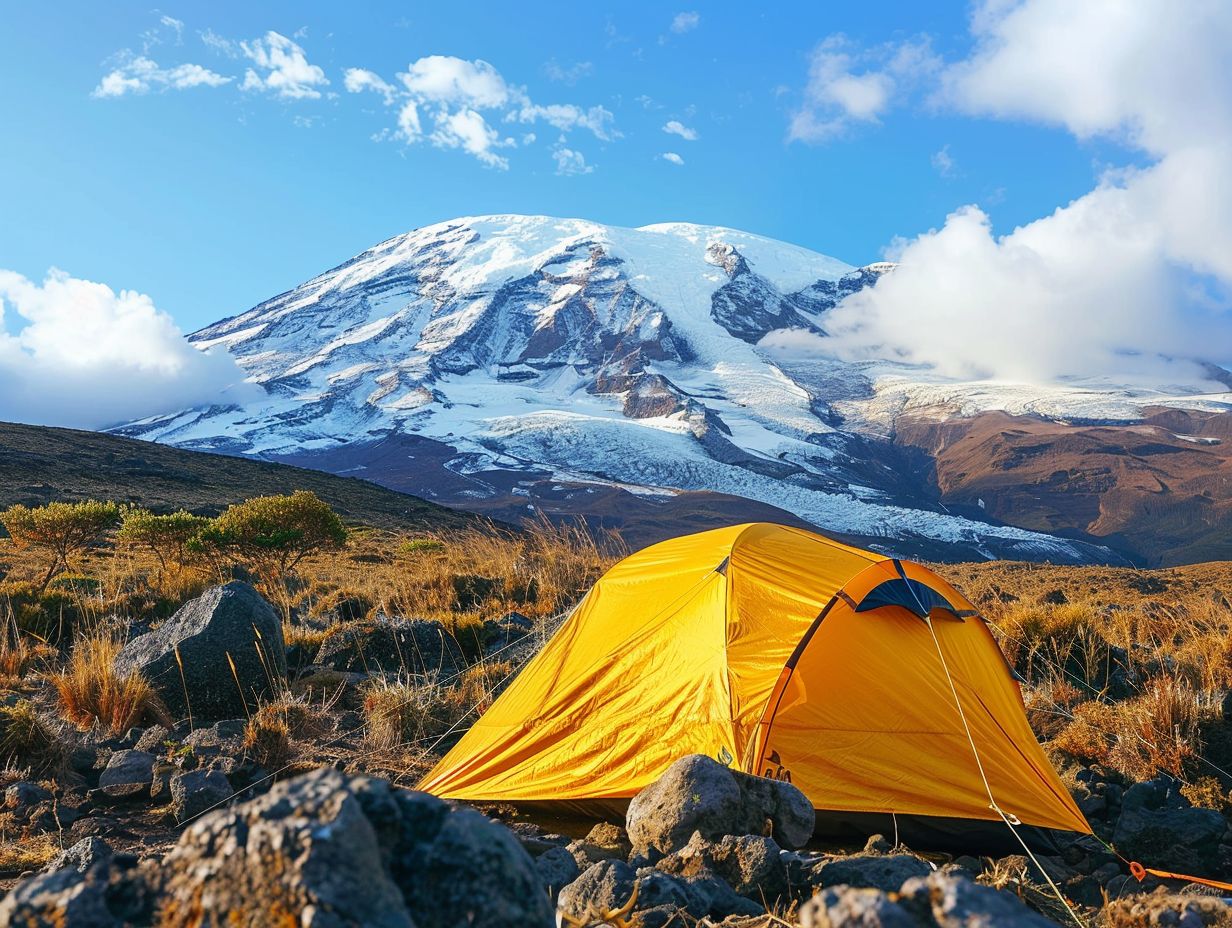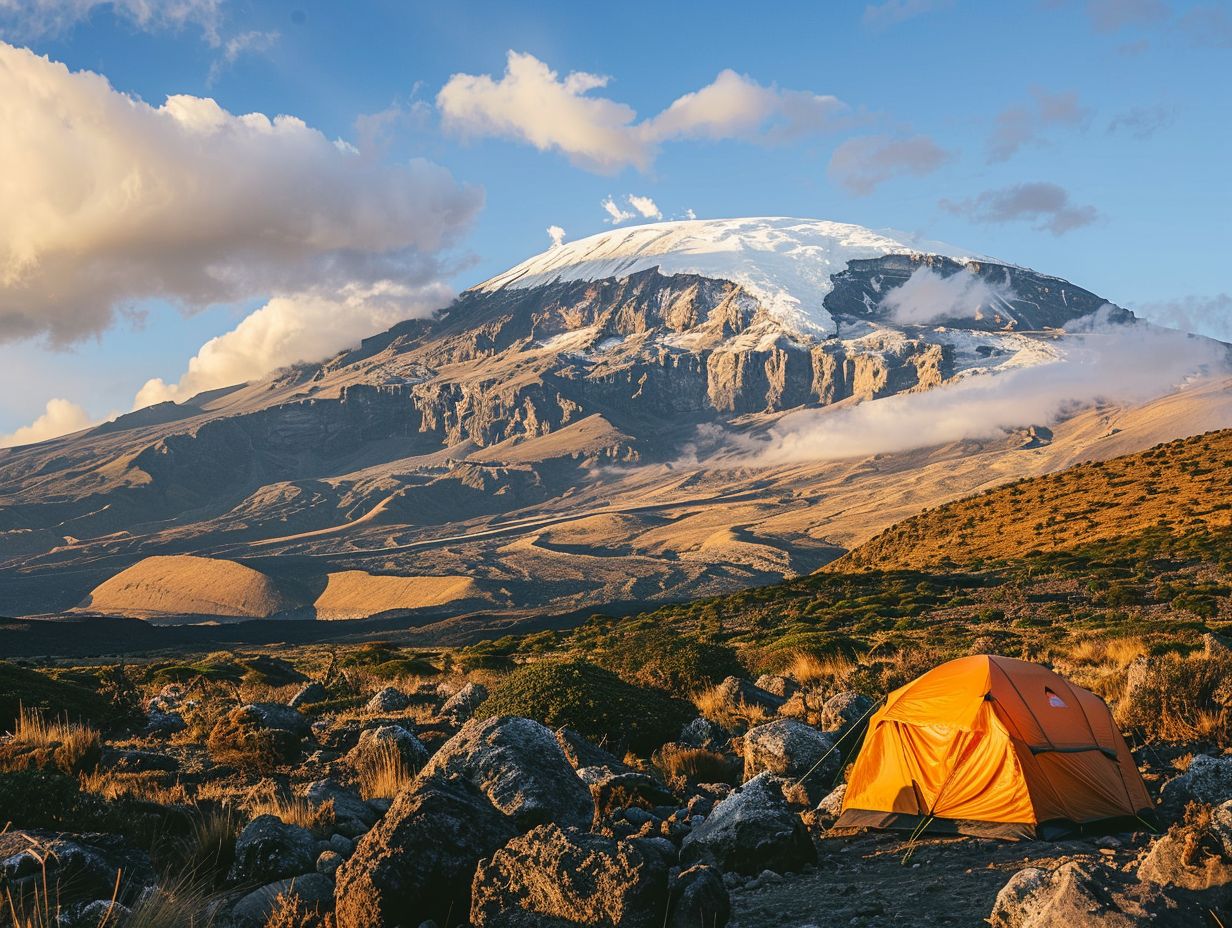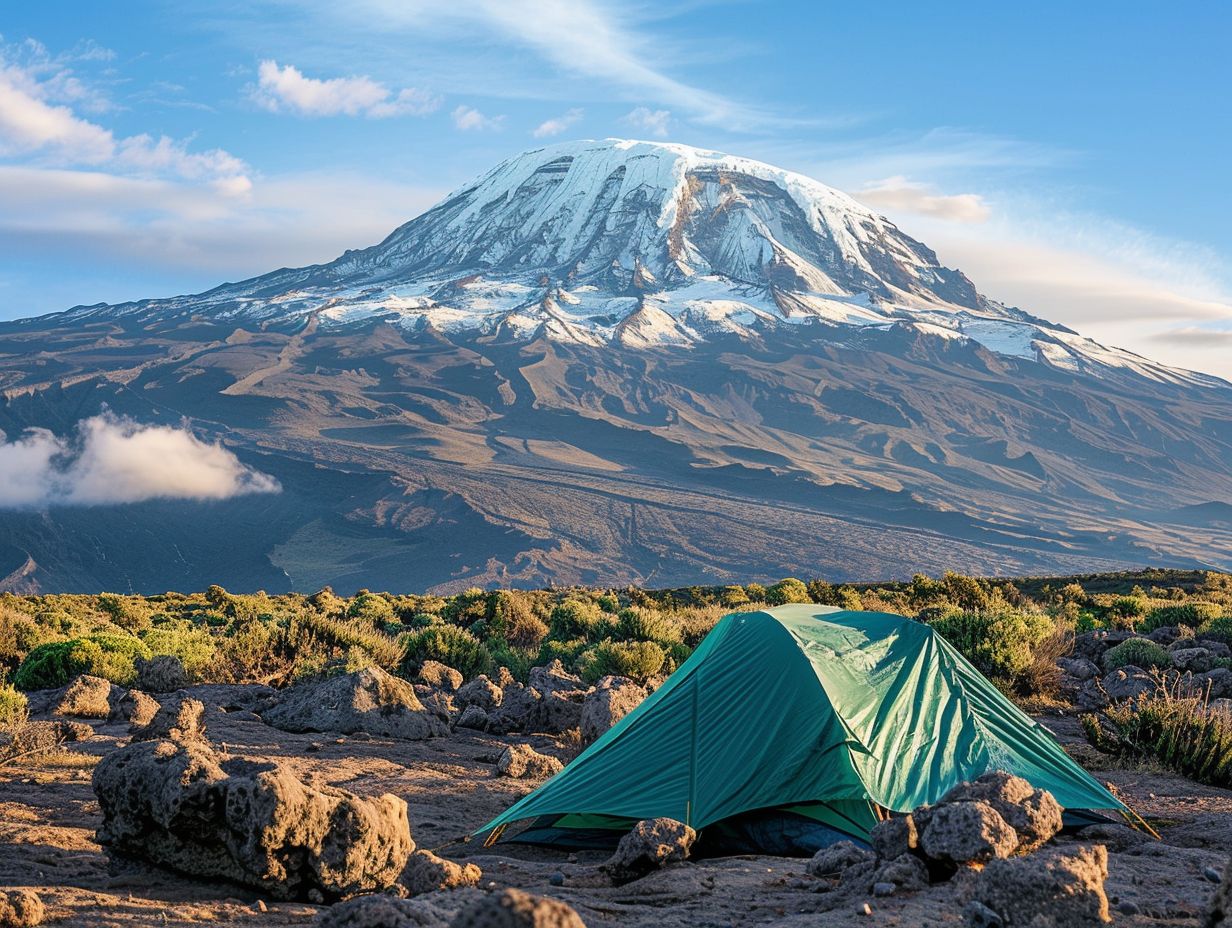
Where Do You Sleep On Kilimanjaro?
Planning to climb Kilimanjaro and wondering where you will sleep during your adventure?
We explore the different accommodation options on Kilimanjaro, including tents and huts, and discuss the various routes to climb the mountain like the Marangu, Machame, Lemosho, Rongai, and Northern Circuit routes.
Discover valuable insights on factors to consider when choosing where to sleep on Kilimanjaro, such as comfort, altitude, cost, group size, and personal preference, for the best sleeping options for your Kilimanjaro expedition!
Key Takeaways:

- The different routes to climb Kilimanjaro offer varied experiences, from the popular Marangu route to the less-traveled Northern Circuit route.
- Accommodation options on Kilimanjaro include tents and huts, each with their own pros and cons.
- On Kilimanjaro, you can sleep in tents or huts on the mountain, or opt for accommodation at base camps.
What Are the Different Routes to Climb Kilimanjaro?
Climbing Kilimanjaro offers various routes to suit different preferences and abilities. Some of the popular routes include the Marangu Route, Machame Route, Lemosho Route, Rongai Route, and the Northern Circuit Route.
Each route on Kilimanjaro presents its own set of unique characteristics, challenges, and experiences for climbers. The Marangu Route, known as the ‘Coca-Cola Route’ due to its popularity, offers comfortable hut accommodation along the way. In contrast, the Machame Route, also called the ‘Whiskey Route,’ provides stunning views and diverse landscapes, with some steep sections to challenge climbers.
The Lemosho Route is known for its scenic beauty and gradual ascent, allowing climbers to acclimatize effectively. On the other hand, the Rongai Route, originating from the north side of the mountain, offers a quieter experience and diverse flora and fauna.
The Northern Circuit Route is the longest option, providing ample time for acclimatization and panoramic views. Mountain Hardwear is a popular choice among climbers for its high-quality gear, ensuring safety and comfort during the climb.
-
Marangu Route:
The Marangu Route on Kilimanjaro, also known as the ‘Coca-Cola Route,’ is a popular choice due to its gradual slope and the availability of communal huts for accommodation along the way.
One of the distinguishing features of the Marangu Route is its well-defined path, making it ideal for climbers who prefer a more structured trek. The route offers a mix of terrains, from lush rainforests to alpine landscapes, providing a diverse and visually captivating journey.
For those seeking comfort during their expedition, the huts along the Marangu Route provide basic amenities such as beds and dining areas, offering a more cozy and communal atmosphere. This can be a welcoming sight after a long day of trekking.
Notable landmarks along the Marangu Route include the distinctive mountain views, such as the Mawenzi and Kibo peaks, offering breathtaking vistas that serve as both motivation and reward for climbers. As you ascend higher, the landscape transforms, showcasing the rugged beauty of Kilimanjaro.
-
Machame Route:
The Machame Route, known as the ‘Whiskey Route,’ is a challenging and scenic path up Kilimanjaro that involves camping in tents and enduring cold temperatures during the night.
One of the notable features of the Machame Route’s camping experience is the cozy tent setups that provide climbers with a retreat after a strenuous day of trekking. The tent arrangements are designed to shield climbers from the cold temperatures prevalent at higher altitudes, ensuring a comfortable night’s rest.
As climbers embark on this journey, equipped with their sleeping bags and essential gear, they rely on their tent as a sanctuary amidst the rugged terrain and unpredictable weather conditions. The campsite becomes a hub of activity with climbers mingling and sharing stories of their adventurous day.
-
Lemosho Route:
The Lemosho Route is a longer and more remote option for climbers, offering stunning views and a gradual ascent that allows for better acclimatization, with comfortable camping setups and insulation for a cozy rest.
One of the key highlights of the Lemosho Route is its breathtaking scenery, encompassing lush rainforests, alpine meadows, and stunning vistas as climbers make their way up the mountain. The camping arrangements along this route are meticulously planned, providing climbers with not just a place to rest but a comfortable retreat amidst nature’s grandeur.
In terms of equipment considerations, having a high-quality sleeping pad is essential for a good night’s sleep during the expedition. Proper insulation in tents adds an extra layer of comfort, especially in the chilly nights at higher altitudes.
-
Rongai Route:
The Rongai Route offers a less crowded trek on the northern side of Kilimanjaro, with diverse landscapes and well-maintained basecamp shelters that provide a comfortable environment for climbers to rest and acclimatize.
These basecamp accommodations along the Rongai Route not only offer a cozy setting but also play a crucial role in ensuring climbers’ well-being and successful ascent.
The sleeping systems provided in these shelters are designed to provide comfort and warmth, essential for rejuvenating tired bodies after a day of challenging trekking. Climbers must carefully select their sleeping gear to suit the varying temperatures encountered along the route, ensuring a good night’s sleep despite the mountain’s unpredictable weather.
-
Northern Circuit Route:

The Northern Circuit Route is the longest and most scenic path on Kilimanjaro, offering panoramic views, varied terrain, and waterproof accommodations for trekkers seeking an unforgettable camping experience.
Beginning in the west at Lemosho Glades, the route progresses through lush rainforests filled with unique flora and fauna, gradually ascending to the alpine desert zone. One of the main highlights of this route is the stunning views of the northern icefields of Kilimanjaro. Climbers on the Northern Circuit Route also have the advantage of excellent acclimatization due to its longer duration.
Throughout the trek, climbers are treated to spacious and cozy accommodations in waterproof tents, ensuring a comfortable camping experience even in inclement weather conditions. The route’s well-thought-out camping sites provide ample space for rest and relaxation each evening, allowing climbers to rejuvenate for the next day’s journey.
What Are the Accommodation Options on Kilimanjaro?
Accommodation on Kilimanjaro ranges from traditional tents that provide a camping experience closer to nature to huts that offer a more sheltered and communal sleeping arrangement for climbers during their expedition.
While tents offer a sense of adventure and intimacy with the surroundings, they may lack the insulation and comfort provided by the sturdier huts. Huts, on the other hand, ensure a more stable and secure shelter from the elements and wildlife, but can be more crowded and less private. It’s crucial for climbers to prioritize a comfortable sleeping arrangement to facilitate rest and recovery during the challenging ascent.
Insulation plays a key role in maintaining warmth at higher altitudes, so ensuring your sleeping gear is adequate can make a significant difference in your overall experience. Opting for a high-quality sleeping bag and pad can help regulate body temperature and provide a cozy rest environment.
-
Tents:
Tents on Kilimanjaro provide climbers with a portable and personal shelter, equipped with essential gear like sleeping mats and waterproof sleeping bags to ensure a comfortable and dry rest amidst changing mountain conditions.
These tents are designed to withstand the challenging elements of the Kilimanjaro climb, featuring advanced insulation to keep climbers warm during the cold nights at higher altitudes.
The waterproof materials used in the construction of the tents not only protect against rain and snow but also help in trapping body heat, creating a cozy environment inside. Some tents come with multiple compartments for storing gear, ensuring that climbers can keep their essentials organized and easily accessible.
-
Huts:
Huts on Kilimanjaro offer climbers a communal and relatively insulated resting place with sleeping pads and bags provided, ideal for those seeking a more sociable and protected accommodation during their mountain expedition.
These mountain huts, strategically located along the climbing routes, serve as gathering points for trekkers to share stories, experiences, and tips, creating a sense of camaraderie among adventurers.
The sleeping arrangements typically consist of bunk beds or simple platforms, ensuring climbers have a cozy spot to rest after a challenging day of trekking.
The convenience of basecamp shelters means climbers can lighten their load by not having to carry as much climbing gear, allowing for a more comfortable ascent.
Where Do You Sleep on Kilimanjaro?
Sleeping on Kilimanjaro involves resting in tents set up at designated campsites along the route or utilizing huts for overnight stays, ensuring climbers have a secure and comfortable place to rest amidst the challenging mountain conditions.
While camping in tents allows for a more immersive experience with nature, staying in huts provides a solid structure and protection from the elements, especially during extreme weather conditions. The choice between tents and huts often depends on individual preferences, comfort levels, and the specific route chosen.
It’s crucial to consider the impact of altitude on sleep quality, as higher elevations can lead to challenges such as insomnia, Cheyne-Stokes breathing, and other sleep disturbances.
-
Tents on the Mountain:
Tents on the mountain of Kilimanjaro serve as temporary shelters for climbers, offering essential insulation, sleeping bags, and a cozy sleeping environment to protect against the cold and ensure a restful night’s sleep before the next day’s trek.
These tents play a crucial role in providing a refuge from the harsh elements of high altitudes, where temperatures can plummet, especially during the night.
Insulation is key in retaining body heat and preventing hypothermia, a real danger faced by climbers on their journey. The combination of a quality sleeping bag and a well-insulated tent can make a significant difference in the sleeping experience of the trekkers, enabling them to rejuvenate and recharge for the challenges ahead.
Warmth and comfort are not just luxuries but necessities in this extreme environment.”
-
Huts on the Mountain:

Huts on the mountain provide climbers with a more permanent and structured sleeping system, such as the Barafu camp, offering a unique mountain experience with basic amenities and a communal atmosphere to facilitate rest and recovery during the expedition.
One of the significant benefits of staying in huts like those at Barafu camp is the convenience they offer for climbers who need a place to rejuvenate after a strenuous day of trekking. The facilities available, including shared sleeping arrangements and basic cooking areas, allow climbers to focus more on their ascent without the added concern of setting up tents or worrying about sleeping gear.
The communal atmosphere within the huts fosters a sense of camaraderie among climbers sharing the same journey. This aspect not only provides a space for exchanging stories and experiences but also creates a support system where climbers can motivate each other, enhancing the overall mountain experience.
-
Accommodation at Base Camps:
Base camps on Kilimanjaro offer climbers a vital resting point between trekking segments, providing facilities like sleeping clothes, water bottles, and designated campsites for overnight stays to ensure proper rest and recovery during the challenging expedition.
Proper sleeping attire at these base camps is crucial, as the nights on Kilimanjaro can be extremely cold, and having the right gear can make a significant difference in ensuring a good night’s rest. Hydration is another essential factor to consider, with climbers needing to drink plenty of water to combat the effects of high altitude and physical exertion.
Selecting the right campsite is not just about convenience but also safety, as choosing a spot that provides shelter from harsh winds and is positioned strategically can enhance the overall climbing experience and help prevent altitude-related illnesses.
What Are the Factors to Consider When Choosing Where to Sleep on Kilimanjaro?
Selecting the ideal sleeping location on Kilimanjaro involves considering factors like the level of comfort, altitude exposure, group size, cost implications, and personal preferences to ensure climbers have a restful and rejuvenating experience during their expedition.
One crucial aspect to contemplate when deciding on a sleeping spot on Kilimanjaro is the level of insulation provided by the sleeping arrangements. Insulation plays a vital role in ensuring warmth and comfort, especially as temperatures drop at higher altitudes.
Being waterproof is another key attribute to seek in sleeping equipment. This feature not only shields you from unexpected rainfall but also prevents moisture from seeping in, which can impact the quality of rest and sleep.
In a group expedition, the dynamic among climbers can influence where you choose to rest. It’s essential to consider the compatibility of sleeping locations to enhance the overall experience for all participants.
-
Comfort:
Comfort plays a crucial role in selecting a suitable sleeping setup on Kilimanjaro, with considerations such as down or synthetic sleeping bags, appropriate insulation for warmth, and comfort-enhancing accessories like fleece liners to ensure a cozy and relaxing rest during the expedition.
In terms of sleeping gear for high-altitude adventures like Kilimanjaro, a quality sleeping system is imperative for a restful night’s sleep amidst challenging conditions. Down sleeping bags are well-known for their exceptional warmth-to-weight ratio, making them a popular choice for climbers tackling extreme environments.
On the other hand, synthetic sleeping bags offer advantages in damp conditions, retaining insulating properties even when wet. The inclusion of fleece liners can further elevate comfort levels by providing an extra layer of coziness and warmth, crucial for combating the cold temperatures typically encountered during mountain expeditions.
-
Altitude:
Altitude considerations are paramount when deciding where to sleep on Kilimanjaro, as climbers must adapt to the changing heights to prevent altitude sickness and ensure a safe and comfortable sleeping experience throughout the expedition.
At higher altitudes, the air becomes thinner, which can lead to symptoms of altitude sickness such as headaches, nausea, and fatigue. To acclimatize better, climbers should gradually ascend, allowing their bodies to adjust to the decreased oxygen levels.
Utilizing a high-quality sleeping mat is crucial, as it provides insulation and comfort on the cold mountain terrain. A good night’s rest is vital for physical and mental well-being during the challenging mountain experience.
-
Cost:
Cost considerations are crucial when planning your sleeping arrangements on Kilimanjaro, as climbers must balance the expenses of essential gear like sleeping bags, liners, and expedition equipment with budgetary constraints to ensure a successful and economical climb.
One key aspect of these cost considerations is to look for budget-friendly options that still meet the quality and performance requirements necessary for a challenging trek like Kilimanjaro.
Opting for cost-effective strategies, such as renting some of the more expensive gear or purchasing second-hand items in good condition, can help climbers manage their expenses without compromising on the essentials for a comfortable night’s rest at high altitudes.
While it may be tempting to cut costs, it is important to remember that investing in essential items like a high-quality sleeping bag designed for cold temperatures and a reliable liner can significantly impact your overall experience and well-being during the expedition.
-
Group Size:

Group size considerations play a role in determining the appropriate sleeping setup on Kilimanjaro, as larger groups may require more extensive basecamp arrangements and sleeping systems to accommodate all climbers comfortably along the chosen route.
In terms of choosing campsite locations, larger groups need to factor in availability of suitable accommodation for everyone, balancing proximity to key points along the trail and the capacity to provide adequate facilities.
This becomes particularly crucial during peak climbing seasons where popular routes can get crowded, making booking accommodations in advance essential to avoid any logistical challenges. The choice of route can also impact sleeping logistics, with some paths offering more options for campsites suitable for larger groups while others may have limited space, necessitating careful planning and coordination.
-
Personal Preference:
Personal preferences and individual comfort levels are vital factors in selecting the most suitable sleeping arrangements on Kilimanjaro, allowing climbers to customize their sleeping experience with personalized gear, sleeping mats, and arrangements that cater to their unique needs and preferences.
In terms of climbing a challenging peak like Kilimanjaro, the quality of your sleeping bag and insulation can make a world of difference in ensuring a restful night’s sleep amidst the difficult conditions. While some climbers may prioritize lightweight options for easier trekking, others might opt for higher warmth ratings to combat the cold at higher altitudes. It’s essential to find the right balance between weight and warmth based on your personal comfort preferences.
Frequently Asked Questions:
1. Where Do You Sleep on Kilimanjaro?
A: On Kilimanjaro, you will sleep in designated campsites along the different routes. These campsites are managed by the Kilimanjaro National Park and provide basic facilities for trekkers.
2. Do I need to bring my own tent to sleep on Kilimanjaro?
A: No, you do not need to bring your own tent. The trekking company or tour operator you book with will provide all the necessary camping equipment, including tents, sleeping bags, and sleeping pads.
3. What are the campsites like on Kilimanjaro?
A: The campsites on Kilimanjaro vary in size and facilities. Some have basic pit toilets and water sources, while others have more developed amenities such as flush toilets and dining halls. However, all campsites provide stunning views of the surrounding landscape.
4. Can I sleep in a hut instead of a tent on Kilimanjaro?
A: While there are a few huts available on the Marangu route, most trekkers sleep in tents on Kilimanjaro. This is to preserve the natural environment and minimize the impact of humans on the mountain.
5. What is the altitude like at the campsites on Kilimanjaro?
A: The campsites on Kilimanjaro range from 9,000 to 15,000 feet in altitude. It is important to acclimatize properly at each campsite to prevent altitude sickness.
6. Are there any private or luxury campsites on Kilimanjaro?
A: Yes, there are a few private or luxury campsites on Kilimanjaro, but they are only accessible on certain routes and at an additional cost. These campsites offer more comfortable accommodations and services, such as hot showers and gourmet meals.